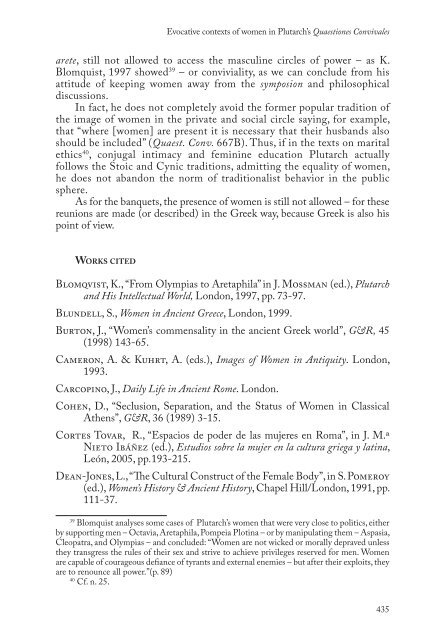- Page 5 and 6:
Se c t i o n 2: Th e Sy m p o s i o
- Page 7:
Se c t i o n 6: Co n v i v i u m Se
- Page 11:
Christopher Pellingways to carry, a
- Page 16 and 17:
Opening Session1
- Page 24 and 25:
Sven-Tage TeodorssonNon-Socratic sy
- Page 26 and 27:
Sven-Tage TeodorssonPlutarch freque
- Page 28 and 29:
Sven-Tage Teodorssonoverwhelming au
- Page 30 and 31:
Sven-Tage TeodorssonMartin, J., Sym
- Page 32 and 33:
Trabajos y Días como hipotexto de
- Page 34 and 35:
Trabajos y Días como hipotexto de
- Page 36 and 37:
Trabajos y Días como hipotexto de
- Page 38 and 39:
Trabajos y Días como hipotexto de
- Page 40 and 41:
Trabajos y Días como hipotexto de
- Page 42 and 43:
Trabajos y Días como hipotexto de
- Page 44 and 45:
Josefa Fernández Zambudiodonde enc
- Page 46 and 47:
Josefa Fernández Zambudioperjudici
- Page 48 and 49:
Josefa Fernández ZambudioBarcenill
- Page 50 and 51:
Timothy E. Dufflink to the theme of
- Page 52 and 53:
Timothy E. DuffPlutarch is here, th
- Page 54 and 55:
Timothy E. Duffmentions, the incide
- Page 56 and 57:
Timothy E. Duffwhere Alcibiades run
- Page 58 and 59:
Timothy E. DuffHe describes Socrate
- Page 60 and 61:
Timothy E. Duffshows Socrates comba
- Page 62 and 63:
Timothy E. DuffKrentz, P., “War
- Page 64 and 65:
Frederick E. Brenkfor guidance, and
- Page 66 and 67:
Frederick E. BrenkIn the very first
- Page 68 and 69:
Frederick E. Brenkor presumed natur
- Page 70 and 71:
Frederick E. BrenkThe role of Theon
- Page 72 and 73:
Frederick E. BrenkHall, J., Lucian
- Page 74 and 75:
Plutarch’s Techne Rhetorike for t
- Page 76 and 77:
Plutarch’s Techne Rhetorike for t
- Page 78 and 79:
Plutarch’s Techne Rhetorike for t
- Page 80 and 81:
Plutarch’s Techne Rhetorike for t
- Page 82 and 83:
Plutarch’s Techne Rhetorike for t
- Page 84 and 85:
Plutarch’s Techne Rhetorike for t
- Page 86 and 87:
Influencia de los progymnasmata en
- Page 88 and 89:
Influencia de los progymnasmata en
- Page 90 and 91:
Influencia de los progymnasmata en
- Page 92 and 93:
Influencia de los progymnasmata en
- Page 94 and 95:
Influencia de los progymnasmata en
- Page 96 and 97:
Influencia de los progymnasmata en
- Page 98 and 99:
Franco Ferrarilogica (διὰ το
- Page 100 and 101:
Franco Ferrariconsiste dunque, seco
- Page 102 and 103:
Franco Ferrariche lo ha preceduto,
- Page 104 and 105:
Franco Ferrariaveva richiamato l’
- Page 107 and 108:
Riddling at table: trivial ainigmat
- Page 109 and 110:
Riddling at table: trivial ainigmat
- Page 111 and 112:
Riddling at table: trivial ainigmat
- Page 113 and 114:
The reading of texts at the Graeco-
- Page 115 and 116:
The reading of texts at the Graeco-
- Page 117 and 118:
The reading of texts at the Graeco-
- Page 119 and 120:
The reading of texts at the Graeco-
- Page 121 and 122:
The reading of texts at the Graeco-
- Page 123 and 124:
Plutarco e la lettura nel simposioP
- Page 125 and 126:
Plutarco e la lettura nel simposioP
- Page 127 and 128:
Plutarco e la lettura nel simposioP
- Page 129 and 130:
Plutarco e la lettura nel simposioD
- Page 131 and 132:
Leading the party, Leading the City
- Page 133 and 134:
Leading the party, Leading the City
- Page 135 and 136:
Leading the party, Leading the City
- Page 137 and 138:
Leading the party, Leading the City
- Page 139 and 140:
A ‘barbarian’ symposium and the
- Page 141 and 142:
A ‘barbarian’ symposium and the
- Page 143 and 144:
A ‘barbarian’ symposium and the
- Page 145 and 146:
A ‘barbarian’ symposium and the
- Page 147 and 148:
A ‘barbarian’ symposium and the
- Page 149 and 150:
A ‘barbarian’ symposium and the
- Page 151 and 152:
A ‘barbarian’ symposium and the
- Page 153 and 154:
A ‘barbarian’ symposium and the
- Page 155 and 156:
Cena apud Catones: ideology and sym
- Page 157 and 158:
Cena apud Catones: ideology and sym
- Page 159 and 160:
Cena apud Catones: ideology and sym
- Page 161 and 162:
Cena apud Catones: ideology and sym
- Page 163 and 164:
Cena apud Catones: ideology and sym
- Page 165 and 166:
Cena apud Catones: ideology and sym
- Page 167 and 168:
Cena apud Catones: ideology and sym
- Page 169 and 170:
Cena apud Catones: ideology and sym
- Page 171 and 172:
Cena apud Catones: ideology and sym
- Page 173 and 174:
Manuel TrösterThe Lives of Flamini
- Page 175 and 176:
Manuel Tröster3) 16 . For another,
- Page 177 and 178:
Manuel Trösterin the Lives, most n
- Page 179 and 180:
Manuel Trösterthoughtful perceptio
- Page 181 and 182:
Manuel Trösterthe most eminent sta
- Page 183 and 184:
Manuel TrösterFerrary, J.-L., Phil
- Page 185 and 186:
Manuel Tröster_____“Introduzione
- Page 187 and 188:
Crassus as Symposiast in Plutarch
- Page 189 and 190:
Crassus as Symposiast in Plutarch
- Page 191 and 192:
Crassus as Symposiast in Plutarch
- Page 193 and 194:
Crassus as Symposiast in Plutarch
- Page 195 and 196:
Crassus as Symposiast in Plutarch
- Page 197 and 198:
Section 3Disruptive Symposia191
- Page 199 and 200:
Jeffrey Benekercrossing from one co
- Page 201 and 202:
Jeffrey BenekerThis discussion lead
- Page 203 and 204:
Jeffrey BenekerThis scene, even mor
- Page 205 and 206:
Jeffrey Benekerbehavior will contin
- Page 207 and 208:
Antonio Ignacio Molina MarínSi en
- Page 209 and 210:
Antonio Ignacio Molina Maríndistri
- Page 211 and 212:
Antonio Ignacio Molina Marín6.4-5;
- Page 213 and 214:
Antonio Ignacio Molina Marínrepres
- Page 215 and 216:
The Banquets of AlexanderThe banque
- Page 217 and 218:
The Banquets of AlexanderBanquet sc
- Page 219 and 220:
The Banquets of Alexanderwith their
- Page 221 and 222:
The Banquets of Alexanderit, while
- Page 223 and 224:
The Banquets of Alexanderbanquet in
- Page 225 and 226:
The Banquets of AlexanderIn fact, t
- Page 227 and 228:
The disruption of an imperial banqu
- Page 229 and 230:
The disruption of an imperial banqu
- Page 231 and 232:
The disruption of an imperial banqu
- Page 233 and 234:
The disruption of an imperial banqu
- Page 235 and 236:
Nuno Simões RodriguesNa vida de Se
- Page 237 and 238:
Nuno Simões Rodriguescomo for, tod
- Page 239 and 240:
Nuno Simões Rodriguestinha gostado
- Page 241 and 242:
Nuno Simões RodriguesÉ ainda da h
- Page 243 and 244:
Nuno Simões Rodriguesnarrativa é
- Page 245 and 246:
Nuno Simões Rodriguesquestões que
- Page 247 and 248:
El banquete traicionero en las Vida
- Page 249 and 250:
El banquete traicionero en las Vida
- Page 251 and 252:
El banquete traicionero en las Vida
- Page 253 and 254:
El banquete traicionero en las Vida
- Page 255 and 256:
El banquete traicionero en las Vida
- Page 257 and 258:
Dámaris Romero Gonzálezpersonas,
- Page 259 and 260:
Dámaris Romero Gonzálezsus compa
- Page 261 and 262:
Dámaris Romero Gonzálezla de su e
- Page 263 and 264:
La notion de philanthrōpia chez Pl
- Page 265 and 266:
La notion de philanthrōpia chez Pl
- Page 267 and 268:
La notion de philanthrōpia chez Pl
- Page 269 and 270:
La notion de philanthrōpia chez Pl
- Page 271 and 272:
La notion de philanthrōpia chez Pl
- Page 273 and 274:
La notion de philanthrōpia chez Pl
- Page 275 and 276:
Anastasios G. Nikolaidisstruck a fa
- Page 277 and 278:
Anastasios G. Nikolaidisparticularl
- Page 279 and 280:
Anastasios G. Nikolaidisin connecti
- Page 281 and 282:
Anastasios G. NikolaidisCrass. 7.3-
- Page 283 and 284:
Anastasios G. Nikolaidisand the man
- Page 285 and 286:
Anastasios G. Nikolaidisπολιτ
- Page 287 and 288:
Anastasios G. NikolaidisDuff, T., P
- Page 289 and 290:
Paola Volpe Cacciatoreplatonico del
- Page 291 and 292:
Paola Volpe CacciatoreÈ la stessa
- Page 293 and 294:
Paola Volpe CacciatoreSe è così -
- Page 295 and 296:
Harvesting the fruits of virtue: ph
- Page 297 and 298:
Harvesting the fruits of virtue: ph
- Page 299 and 300:
Harvesting the fruits of virtue: ph
- Page 301 and 302:
Harvesting the fruits of virtue: ph
- Page 303 and 304:
Harvesting the fruits of virtue: ph
- Page 305 and 306:
Maria Leonor Santa Bárbaranos poet
- Page 307 and 308:
Maria Leonor Santa BárbaraAmor? Is
- Page 309 and 310:
Maria Leonor Santa BárbaraFlaceli
- Page 311 and 312:
Rosario Scannapiecofrequentazione d
- Page 313 and 314:
Rosario Scannapiecouomini viene al
- Page 315 and 316:
Rosario ScannapiecoAd esempio, nei
- Page 317 and 318:
Rosario ScannapiecoL’idea della s
- Page 319 and 320:
Rosario Scannapiecoin cui si afferm
- Page 321 and 322:
Rosario Scannapiecointende, l’uni
- Page 323 and 324:
Rosario ScannapiecoIl costante rico
- Page 325 and 326:
Rosario ScannapiecoBrioso, M., “E
- Page 327 and 328:
Rosario ScannapiecoMartin Jr., H. M
- Page 329 and 330:
Rosario ScannapiecoTsouvala, G.,
- Page 331 and 332:
Marta Várzeastruly fertile period
- Page 333 and 334:
Marta VárzeasAt once, then, the At
- Page 335 and 336:
Marta Várzeasand condemns the youn
- Page 337 and 338:
Marta Várzeasa dishonorable death
- Page 339 and 340:
Vicente M. Ramón Palermpostre, que
- Page 341 and 342:
Vicente M. Ramón Palermla presenci
- Page 343 and 344:
Vicente M. Ramón Palerm- 22, 2:
- Page 345 and 346:
Vicente M. Ramón Palermestadista.
- Page 347 and 348:
Vicente M. Ramón Palerm_____ “Fo
- Page 349 and 350:
José M. Candau Morónde las relaci
- Page 351 and 352:
José M. Candau Morónfiguras emble
- Page 353 and 354:
José M. Candau Morónlos sobreente
- Page 355 and 356:
O sentido de philanthropia nas biog
- Page 357 and 358:
O sentido de philanthropia nas biog
- Page 359 and 360:
O sentido de philanthropia nas biog
- Page 361 and 362:
O sentido de philanthropia nas biog
- Page 363 and 364:
Section 5Quaestiones Convivales367
- Page 365 and 366:
Geert Roskamis discussed and justif
- Page 367 and 368:
Geert Roskamgarlands (645D-646A). P
- Page 369 and 370:
Geert RoskamDe profectibus in virtu
- Page 371 and 372:
Geert Roskamto get a grip on even t
- Page 373 and 374:
Geert RoskamPlato’s Republic (372
- Page 375 and 376: Geert RoskamFavorinus’ education
- Page 377 and 378: Geert Roskam_____ In Search of the
- Page 379 and 380: The symposium in Plutarch’s Table
- Page 381 and 382: The symposium in Plutarch’s Table
- Page 383 and 384: The symposium in Plutarch’s Table
- Page 385 and 386: The symposium in Plutarch’s Table
- Page 387 and 388: The symposium in Plutarch’s Table
- Page 389 and 390: Frances B. Titchenerthat this passa
- Page 391 and 392: Frances B. TitchenerAllowed at a Fe
- Page 393 and 394: Frances B. Titchenerto accentuate t
- Page 395 and 396: Dancing with Plutarch: dance and da
- Page 397 and 398: Dancing with Plutarch: dance and da
- Page 399 and 400: Dancing with Plutarch: dance and da
- Page 401 and 402: Dancing with Plutarch: dance and da
- Page 403 and 404: Dancing with Plutarch: dance and da
- Page 405 and 406: Dancing with Plutarch: dance and da
- Page 407 and 408: The omnipresence of philosophy in P
- Page 409 and 410: The omnipresence of philosophy in P
- Page 411 and 412: The omnipresence of philosophy in P
- Page 413 and 414: The omnipresence of philosophy in P
- Page 415 and 416: The omnipresence of philosophy in P
- Page 417 and 418: Evocative contexts of women in Plut
- Page 419 and 420: Evocative contexts of women in Plut
- Page 421 and 422: Evocative contexts of women in Plut
- Page 423 and 424: Evocative contexts of women in Plut
- Page 425: Evocative contexts of women in Plut
- Page 429 and 430: Evocative contexts of women in Plut
- Page 431 and 432: Aldo Setaiolibut both writers, as w
- Page 433 and 434: Aldo Setaiolireferring to all mushr
- Page 435 and 436: Aldo Setaiolitranslation in Latin h
- Page 437 and 438: Aldo SetaioliMost, G. W., “Cornut
- Page 439 and 440: Aurelio Pérez Jiméneza la interpr
- Page 441 and 442: Aurelio Pérez Jiménezseñalarse e
- Page 443 and 444: Aurelio Pérez JiménezPues bien, q
- Page 445 and 446: Aurelio Pérez Jiménezcomo putrefa
- Page 447 and 448: Section 6Convivium Septem Sapientiu
- Page 449 and 450: José Vela Tejadacomo ya pudimos ap
- Page 451 and 452: José Vela Tejadarecuerda la anécd
- Page 453 and 454: José Vela Tejadavoluntad de adscri
- Page 455 and 456: José Vela Tejadalos Sabios, el alm
- Page 457 and 458: José Vela Tejadadesde la tradició
- Page 459 and 460: José Vela TejadaSirinelli, J., Plu
- Page 461 and 462: Rodolfo González Equihuaescolar 5
- Page 463 and 464: Rodolfo González Equihuasu histori
- Page 465 and 466: Rodolfo González Equihuaprincipal
- Page 467 and 468: Rodolfo González Equihuade Lucas (
- Page 469 and 470: Historical Fiction, Brachylogy, and
- Page 471 and 472: Historical Fiction, Brachylogy, and
- Page 473 and 474: Historical Fiction, Brachylogy, and
- Page 475 and 476: Historical Fiction, Brachylogy, and
- Page 477 and 478:
Historical Fiction, Brachylogy, and
- Page 479 and 480:
Historical Fiction, Brachylogy, and
- Page 481 and 482:
Historical Fiction, Brachylogy, and
- Page 483 and 484:
Historical Fiction, Brachylogy, and
- Page 485 and 486:
Stephen T. Newmyerto the order in w
- Page 487 and 488:
Stephen T. Newmyerhis own defense o
- Page 489 and 490:
Stephen T. Newmyerconnection betwee
- Page 491 and 492:
Stephen T. NewmyerBrink, C. O., “
- Page 493 and 494:
Roosevelt Araújo da Rocha JúniorS
- Page 495 and 496:
Roosevelt Araújo da Rocha JúniorP
- Page 497 and 498:
The tyrannos as a sophos in the Sep
- Page 499 and 500:
The tyrannos as a sophos in the Sep
- Page 501 and 502:
The tyrannos as a sophos in the Sep
- Page 503 and 504:
The tyrannos as a sophos in the Sep
- Page 505 and 506:
The tyrannos as a sophos in the Sep
- Page 507 and 508:
The tyrannos as a sophos in the Sep
- Page 509 and 510:
Index rerumAntigonus III Doson (Mac
- Page 511 and 512:
Index rerum266; 268; 270 (n. 84); 2
- Page 513 and 514:
Index rerumconcept 208; 263‐273;
- Page 515 and 516:
Index rerum300 (n. 15); 301 (n. 22)
- Page 517 and 518:
Index locorumIndex locorumAchilles
- Page 519 and 520:
Index locorum1300-1325 4151308-1313
- Page 521 and 522:
Index locorum2.1.64-66 2112.1.66 42
- Page 523 and 524:
Index locorum11 422Epictetus 2673.2
- Page 525 and 526:
Index locorumHomerus vi, 25, 31, 10
- Page 527 and 528:
Index locorumMusonius Rufus 426, 43
- Page 529 and 530:
Index locorum219d 39219e 38 n. 9, 4
- Page 531 and 532:
Index locorum146D-148B 482146D 518
- Page 533 and 534:
Index locorum479C 265 n. 23479D 265
- Page 535 and 536:
Index locorum633e 70634d-e 70635b 4
- Page 537 and 538:
Index locorum737D-E 26737E 65, 125,
- Page 539 and 540:
Index locorumAemilius Paullus1 166
- Page 541 and 542:
Index locorum15.3 137 n. 4115.4 134
- Page 543 and 544:
Index locorum1.5 268 n. 581.7-8 351
- Page 545 and 546:
Index locorum2.2 181 n. 45.5 447 n.
- Page 547 and 548:
Index locorumSuetonius 237Augustus4
- Page 549 and 550:
Index locorum46-96 135 n. 28Zeno Ci
- Page 551 and 552:
Dá m a r i s Ro m e r o Go n z á
- Page 553 and 554:
Jo a q u i m J. S. Pinheiro is Assi
- Page 555 and 556:
Philip A. St a d t e r is Professor
















